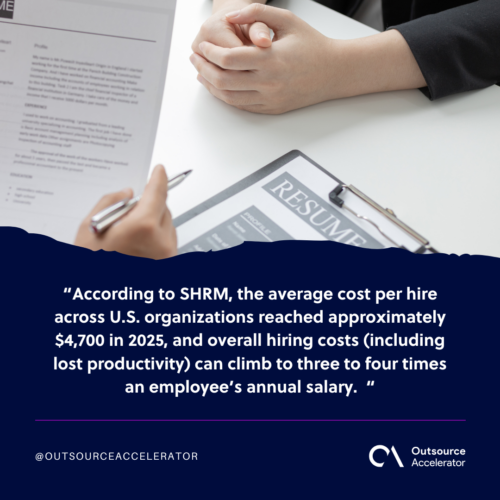10 Talent acquisition metrics your team should master

Hiring the right people takes more than just posting job ads and conducting interviews; it requires a thoughtful, data-driven approach.
That’s where talent acquisition comes in. It’s the ongoing strategy of attracting and hiring candidates who fit both the role and the company culture.
For hiring teams juggling multiple roles and deadlines, knowing what works (and what doesn’t) is of great importance. Talent acquisition metrics help teams track performance, spot bottlenecks, and improve the hiring process.
In this article, we’ll walk you through the ten practical talent acquisition metrics your team should master to hire with more confidence and clarity.
Importance of utilizing talent acquisition metrics
Data-driven hiring teams make better choices. According to SHRM, the average cost per hire across U.S. organizations reached approximately $4,700 in 2025, and overall hiring costs (including lost productivity) can climb to three to four times an employee’s annual salary.
That kind of investment demands clarity and control. Tracking talent acquisition metrics gives teams real insight into efficiency, quality, and candidate experience.

More so, these key performance indicators can help in these areas:
- Control hiring spend. Measuring cost per hire lets teams identify where budgets leak (e.g., agency fees, advertising, or lengthy interview cycles) and address unnecessary cost drivers.
- Speed up hiring timelines. Tracking time‑to‑fill and time‑to‑accept helps surface slow stages in the process so teams can act quickly to bring candidates on board before they lose interest.
- Refine candidate experience. Hiring teams can spot where candidates disengage and optimize communication and flow by analyzing drop-off rates, feedback scores, and stage durations.
- Improve hiring quality. Metrics such as first-year retention, performance ratings, and offer acceptance rates reveal which hires contribute the most, and which sourcing paths yield stronger results.
- Align recruitment with business goals. Comparing internal performance against industry benchmarks enables teams to set realistic targets, forecast hiring needs, and tailor recruitment strategy to organizational priorities.
Tracking these metrics equips hiring teams with the actionable insight needed to reduce costs, smooth operations, and secure stronger hires efficiently.
10 Talent acquisition metrics your team should be tracking
Hiring without tracking performance is like flying blind. Talent acquisition metrics help teams understand what’s working, where gaps exist, and how to hire better.
Now, let’s jump into the ten key metrics your team should consistently monitor:
1. Time to fill
Time to fill measures the number of days it takes to hire someone from the moment a job opens to when the candidate accepts the offer. Tracking this metric helps recruiters identify delays in sourcing, screening, or approvals.
A long time to fill may signal process inefficiencies or unrealistic job requirements.
2. Time to hire
Time to hire looks specifically at the number of days between when a candidate enters the pipeline (e.g., applies or is contacted) and when they accept the job offer. This demonstrates how quickly your team responds after identifying qualified talent.
A shorter time to hire often leads to lower candidate drop-off rates.
3. Cost per hire
This metric captures all recruiting-related expenses (i.e., job ads, software, recruiter salaries, and referral bonuses) divided by the number of hires. Tracking cost per hire helps teams stay on budget and identify areas where spending can be reduced without sacrificing quality.
4. Quality of hire
Quality of hire reflects how well new employees perform and stay with the company over time. You can measure it using first-year performance ratings, retention rates, or manager feedback.
This metric reveals which hiring sources and practices lead to strong long-term hires.
5. Candidate experience score
Candidate experience can impact your employer brand. Use surveys or Net Promoter Score (NPS) to gather feedback from candidates after the hiring process.
Tracking candidate experience helps recruiters improve communication, interview structure, and overall engagement.
6. Offer acceptance rate
The offer acceptance rate indicates the percentage of candidates who accept your job offers compared to the number of offers extended. A low rate may indicate issues with compensation, unclear job expectations, or a poor candidate experience.
Measuring this kpi helps improve the offer strategy and close top candidates more effectively.

7. Source of hire
This metric tracks where your best candidates come from, whether referrals, job boards, social media, or direct outreach. It helps you invest time and budget into the most effective channels and optimize your overall recruitment spend.
8. First-year turnover rate
First-year turnover tracks how many new hires leave within 12 months. A high rate may signal poor onboarding, misalignment between job expectations and reality, or culture fit issues.
9. Interview-to-offer ratio
Interview-to-offer ratio measures how many interviews are conducted before an offer is made. A high ratio may suggest inefficiencies in the screening process or unclear role requirements.
Reducing this number often leads to faster hiring and less wasted effort across the team.
10. Hiring manager satisfaction
Gathering feedback from hiring managers helps assess how well the recruiting process meets internal expectations. Use surveys post-hire to track satisfaction with candidate quality, process speed, and overall experience.
Hiring manager satisfaction kpi strengthens collaboration between recruiters and hiring teams.
Tracking these talent acquisition metrics enables your team to enhance hiring outcomes, ultimately leading to a stronger and more productive workforce.
Using talent acquisition metrics to jazz up the hiring process
Utilizing talent acquisition metrics enables hiring teams to optimize their processes. With the right data, you can quickly identify roadblocks, reduce delays, and focus on what actually attracts top talent.
It’s not about more reports; it’s about making better decisions that lead to better hires. Let the numbers guide your team to a faster, smoother hiring process.







 Independent
Independent




